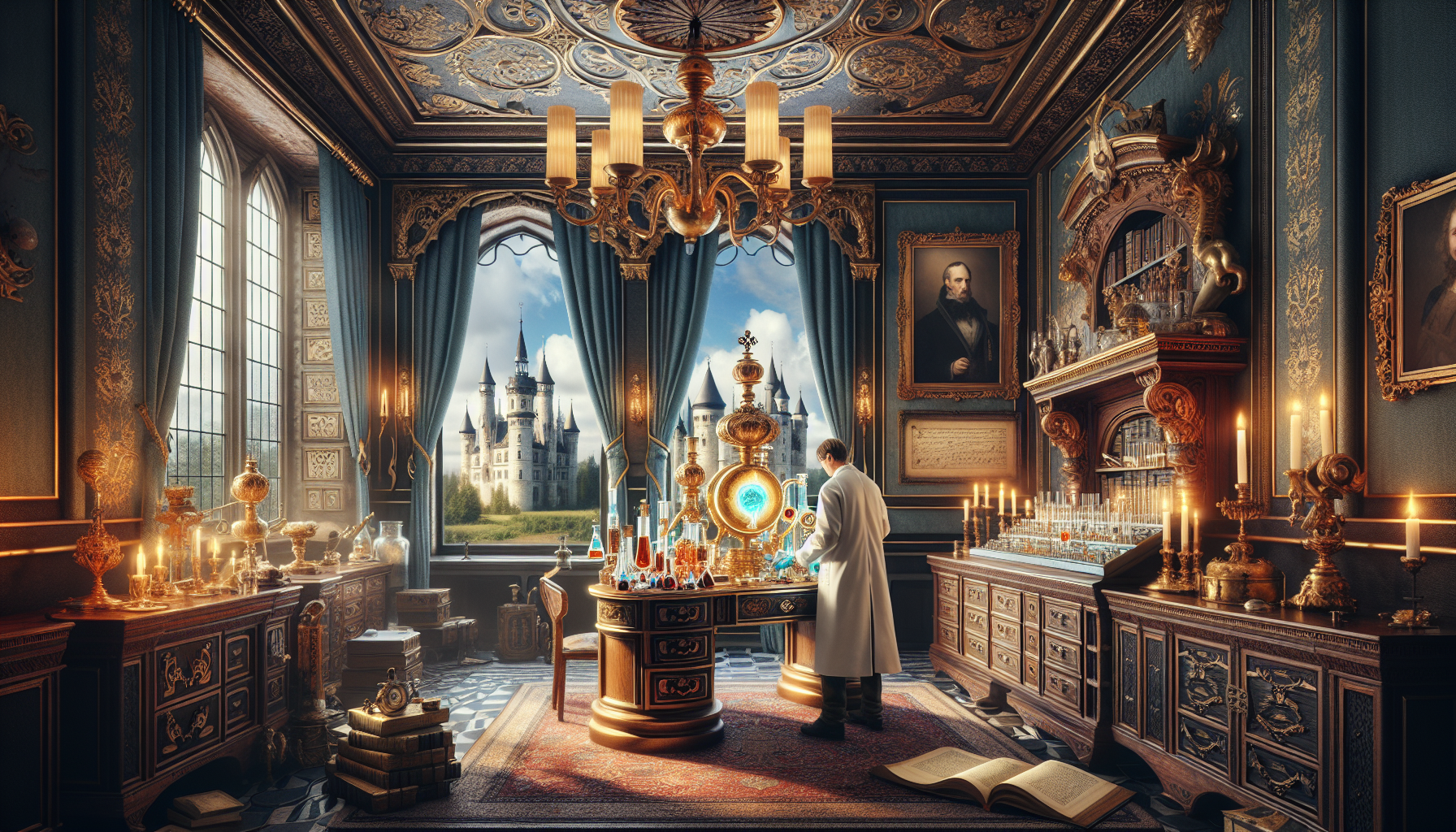Throughout the annals of history, the allure of royalty has captivated the human imagination. The opulent lifestyles, majestic ceremonies, and storied traditions of noble families have been subjects of fascination, intrigue, and sometimes envy. Yet, beyond the glittering crowns and velvet robes lies a deeper enigma that has puzzled scientists and historians alike: the concept of “blue blood.” What is it about these esteemed lineages that sets them apart, not just socially and politically, but genetically? In this article, we delve into the royal secrets of blue blood, unraveling the scientific mysteries behind the exclusive genetic makeup of nobility and examining how these hereditary traits have influenced the course of history. 👑🔬
To truly understand the phenomenon of blue blood, we must first explore the historical context and origins of this concept. The term “blue blood” has its roots in the Spanish phrase “sangre azul,” which was used to distinguish the old noble families from the newer, wealthy classes. It was believed that the aristocrats, who claimed descent from the Visigoths, possessed a certain purity of lineage that was visually represented by their fair skin, through which their veins appeared blue. But is there more to this than just a cultural myth? Recent advancements in genetic research have begun to shed light on the hereditary markers that may contribute to the distinct attributes of noble lineages. By examining the genetic codes of royal families, scientists have identified specific traits that have been passed down through generations, potentially offering insights into their longevity, health, and even cognitive abilities.
As we journey through this exploration, we will uncover the role of genetics in preserving noble lineages and the implications of these findings for our understanding of human evolution. We will discuss the potential advantages and disadvantages conferred by certain genetic traits, and how they have influenced the lives and reigns of historical figures. Furthermore, we will address the ethical considerations and controversies surrounding genetic research within royal families, including issues of privacy and the impact of modern science on traditional beliefs. Ultimately, this article aims to provide a comprehensive and engaging examination of the royal secrets of blue blood, inviting readers to ponder the profound ways in which genetics can shape both individual destinies and the legacy of entire dynasties. Prepare to embark on a captivating journey into the heart of nobility’s genetic legacy, where science meets history, and legends come to life. 🧬✨
Introduction to Blue Blood Lineage: A Historical Overview
The concept of “blue blood” has intrigued historians, scientists, and the general populace for centuries. Originating from the Spanish term “sangre azul,” this idea is often associated with the noble families of Europe, believed to be descendants of a divine or superior lineage. The notion is steeped in history, tracing back to the times when noble families differentiated themselves from commoners not just through wealth and land, but through supposed blood purity. In this section, we’ll delve into the historical origins of blue blood lineage and how it has shaped our understanding of nobility and genetics.
The term “blue blood” is often linked to the visible blue veins of the pale-skinned aristocracy in Europe, who spent more time indoors, away from the harsh sun that tanned the skin of the working class. This physical distinction became a symbol of purity and superiority. However, the idea of nobility being tied to bloodlines is much older and can be found in various ancient civilizations where rulers were considered to be direct descendants of gods or chosen by divine forces. Such beliefs have pervaded many cultures, influencing social structures and inheritance laws.
Throughout history, noble families have maintained their status and power through strategic marriages, often within a closed circle of other noble families, to preserve their bloodline. This practice has led to a concentration of wealth and power, but also to genetic issues due to inbreeding. The concept of noble bloodlines is not just about social status; it has significant implications for genetic diversity and evolution. In the next sections, we will explore the scientific aspects of these noble lineages and how they have impacted modern genetics.
The Science Behind Noble Genetics: Understanding Hereditary Traits
The hereditary aspect of noble lineages has been a topic of interest in genetic studies. Scientists have long been fascinated by the unique genetic traits that seem to persist within certain noble families. These traits, ranging from physical characteristics to predispositions to certain diseases, provide a window into the genetic makeup of historical populations. Understanding these hereditary traits requires a deep dive into genetic science, focusing on DNA, genes, and the mechanisms of inheritance.
Genetic research has revealed that noble families often exhibit certain genetic markers that are rare in the general population. These markers are a result of generations of intermarriage within a limited gene pool. While some traits might be considered advantageous, such as resistance to specific diseases, others can be detrimental, leading to genetic disorders. This phenomenon is well-documented in the history of European nobility, where instances of hemophilia and other hereditary conditions were prevalent.
Advancements in genetic science have allowed researchers to map the genomes of individuals from noble lineages, providing insights into the impact of historical mating patterns on genetic diversity. The study of these genomes not only helps us understand the past but also offers potential applications in modern medicine. Genetic research into noble bloodlines has the potential to uncover the basis of hereditary diseases, paving the way for new treatments and preventive measures.
Comparing Noble and Common Genetic Profiles
To understand the distinct genetic makeup of noble families, it’s essential to compare their genetic profiles with those of common populations. This comparison can highlight specific genetic variations that are either unique to or more prevalent in noble lineages. The following table presents a simplified comparison of some genetic traits observed in noble and common genetic profiles:
| Trait | Noble Lineage | Common Population |
|---|---|---|
| Prevalence of Hemophilia | Higher | Lower |
| Resistance to Specific Diseases | Moderate to High | Variable |
| Genetic Diversity | Lower | Higher |
This table illustrates how certain traits are more commonly associated with noble lineages due to historical patterns of endogamy, which is the practice of marrying within a specific social group. Endogamy has led to a concentration of certain genetic traits, both beneficial and harmful, within noble families.
Implications of Noble Genetics on Modern Society
The study of noble genetics has far-reaching implications for modern society. While the historical context of noble bloodlines might seem distant, the genetic legacies of these lineages continue to influence contemporary health and social structures. The concentration of wealth and power within certain families has parallels in today’s world, where economic and social capital often remain within established networks, reminiscent of the noble bloodlines of the past.
Moreover, understanding the genetic predispositions within noble lineages can have practical applications in medicine. As genetic research advances, the ability to trace hereditary conditions within these families offers valuable data for developing new medical treatments. For instance, studying the genetic basis of hemophilia in noble families has contributed to a better understanding of the disease and the development of gene therapies.
As society becomes increasingly interested in ancestry and genetic heritage, the allure of tracing one’s lineage back to noble ancestors has grown. This trend is fueled by advances in DNA testing, which allow individuals to explore their genetic roots with unprecedented accuracy. Companies offering genetic testing services have seen a surge in interest, as people seek to uncover hidden connections to historical figures and noble bloodlines.
The Role of DNA Testing in Unveiling Ancestry
DNA testing has revolutionized the way we perceive ancestry and genetics. By analyzing specific markers within an individual’s genome, these tests can provide insights into ethnic backgrounds, ancestral migrations, and potential connections to notable historical figures. For those with a curiosity about their lineage, DNA testing offers a tangible link to the past.
One of the most intriguing aspects of DNA testing is its ability to reveal unexpected connections. Individuals who believed they had no ties to nobility may discover distant relations to noble families, challenging their perceptions of identity and heritage. However, it’s important to approach these findings with caution and a critical understanding of genetic science, as the interpretation of DNA results can be complex and sometimes misleading.
As more people engage with DNA testing, the database of genetic information continues to grow, enhancing the accuracy and scope of ancestry analyses. This expansion not only benefits individuals but also contributes to broader scientific research, enabling a deeper understanding of human history and evolution. For those interested in exploring their own genetic lineage, DNA testing can be a powerful tool, but it should be complemented by historical research and a nuanced understanding of genetic science.
- Explore the historical context of noble bloodlines through DNA testing.
- Understand the implications of genetic research on hereditary conditions.
- Consider the societal impact of concentrated wealth and power within families.
For a visual exploration of the role of genetics in tracing noble lineages, watch this insightful video from the Genetics and History Channel.

Conclusion
Certainly! Here’s a comprehensive conclusion for your article on “The Royal Secrets of Blue Blood: Unveiling the Science Behind Nobility’s Exclusive Genetic Lineage”:
—
In conclusion, the exploration of “The Royal Secrets of Blue Blood: Unveiling the Science Behind Nobility’s Exclusive Genetic Lineage” has taken us on a journey through time, science, and society, highlighting the intricate weave of genetics, history, and culture. This topic not only unveils fascinating insights into the past but also offers a deeper understanding of how perceived social hierarchies can intertwine with biological narratives.
Firstly, we delved into the historical context of royal bloodlines, discussing how the notion of ‘blue blood’ emerged as a symbol of nobility. The historical exclusivity and mystique surrounding royal families have long captivated societies, serving both as a source of intrigue and a means of reinforcing social structures. This fascination is not merely a relic of the past but continues to echo in modern times, reminding us of the enduring human interest in lineage and legacy.
Secondly, we examined the scientific underpinnings of these noble lineages, investigating how genetic research has revealed patterns of inheritance that were once shrouded in mystery. Advances in genetic technology have enabled researchers to trace ancestry with unprecedented accuracy, uncovering connections that span continents and centuries. Through these scientific revelations, we gain a clearer picture of how genetic traits are passed down, potentially explaining certain traits associated with royal families.
Furthermore, the article discussed the implications of genetic continuity in royal families, touching upon the ethical considerations and the impact of such discoveries on contemporary discussions about identity and heritage. The conversation around genetics and nobility challenges us to reflect on the societal constructs of class and privilege, urging a reevaluation of how we perceive and value lineage in the modern world.
The importance of this topic lies not only in its ability to illuminate the past but also in its potential to shape future dialogues about genetics and social stratification. As we continue to unravel the mysteries of human genetics, we must remain mindful of the ethical dimensions that accompany such knowledge, ensuring that it is used to foster inclusivity and understanding rather than division.
We encourage you, our reader, to reflect on the insights presented here. Consider how the confluence of genetics and social history informs your understanding of identity and belonging. Share your thoughts and engage in discussions with others who are equally fascinated by the intersections of science, history, and society. By doing so, you contribute to a more informed and connected community.
Additionally, we invite you to explore further. Below are some resources that can deepen your understanding and spark new questions:
1. Genetic Ancestry and Health: What Your DNA Reveals
2. Understanding the Genetics Behind Human Traits
3. The Role of Genetics in Historical Lineages
In sharing this article, you have the power to inspire curiosity and foster conversations that bridge the gap between history and science. Together, let’s continue to explore the profound connections that shape our world, appreciating the complex tapestry of human existence. 🌍✨
—
Feel free to use and adapt this conclusion as needed, ensuring it aligns with your article’s tone and style.
Toni Santos is a visual storyteller and conceptual archivist whose work explores the curious, often poetic ruins of pseudoscience and obsolete theories. With a reverence for forgotten frameworks and fantastical logic, Toni illuminates the imaginative spaces where science once drifted into myth, speculation, and symbolic belief.
His creative path is rooted in a fascination with the fringe — from phrenology maps to ether diagrams, hollow earth charts to animal magnetism illustrations. Each visual Toni creates or curates is an invitation to reexamine the strange beauty of discarded knowledge — not as failure, but as cultural reflection, as art born from our eternal desire to explain the unexplainable.
Blending visual design with historical inquiry, Toni gives new life to lost diagrams, metaphysical charts, and antique engravings that once shaped worldviews. His work occupies the liminal zone between fact and fiction, where obsolete models still pulse with philosophical resonance and forgotten charm.
As the mind behind Vizovex, Toni shares illustrated essays, curated collections, and visual reinterpretations that invite others to explore the aesthetic and symbolic value of outdated theories. His goal is not to validate, but to remember — to view these speculative systems as relics of human creativity, vulnerability, and yearning.
His work is a tribute to:
The elegance of error in the evolution of knowledge
The symbolic artistry of discarded explanations
The blurred lines between belief, observation, and imagination
Whether you’re a collector of curious ideas, a lover of forgotten diagrams, or someone drawn to the strange scaffolding of old worldviews, Toni opens a portal to a time when the universe was still full of ghosts, humors, and cosmic fluids — one chart, one symbol, one discredited wonder at a time.





